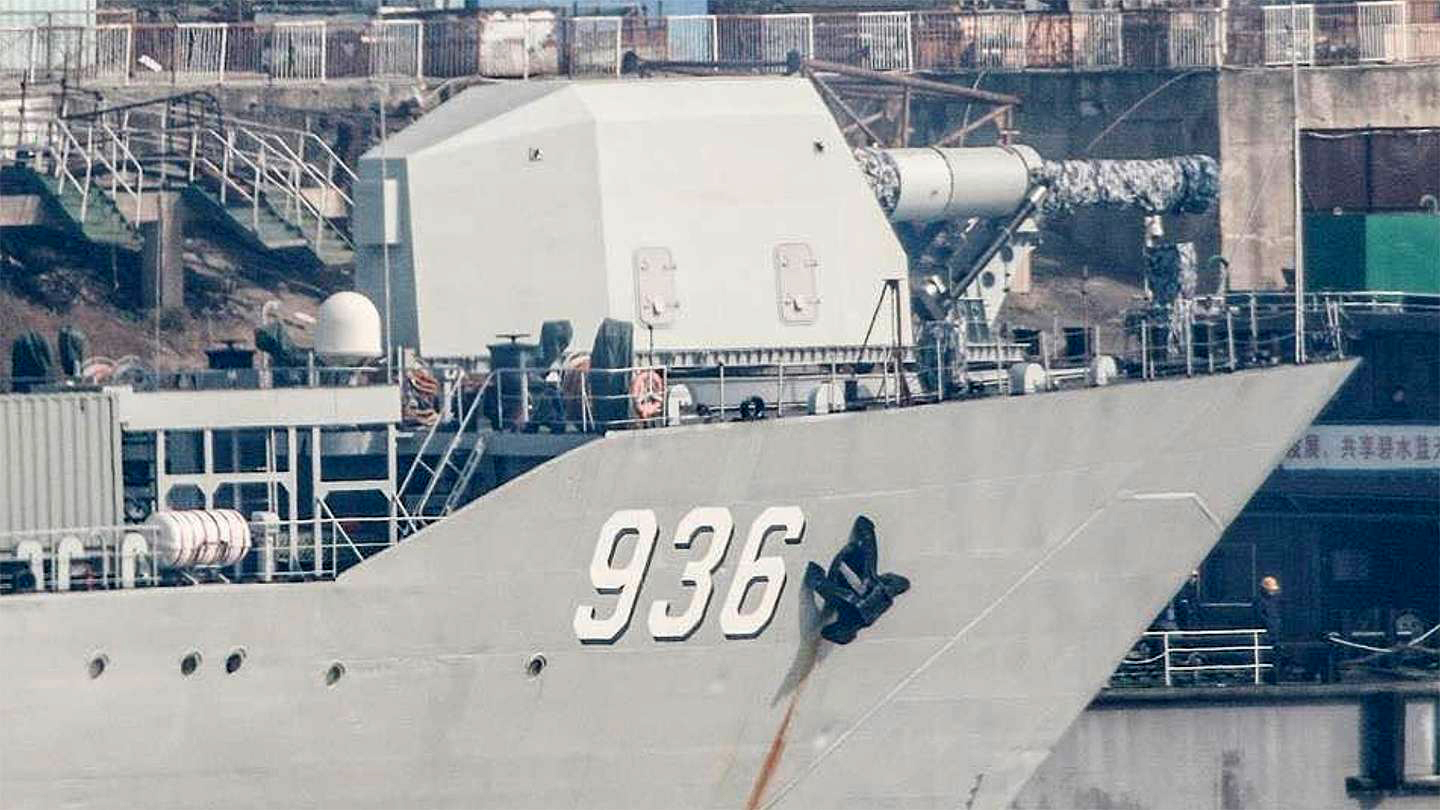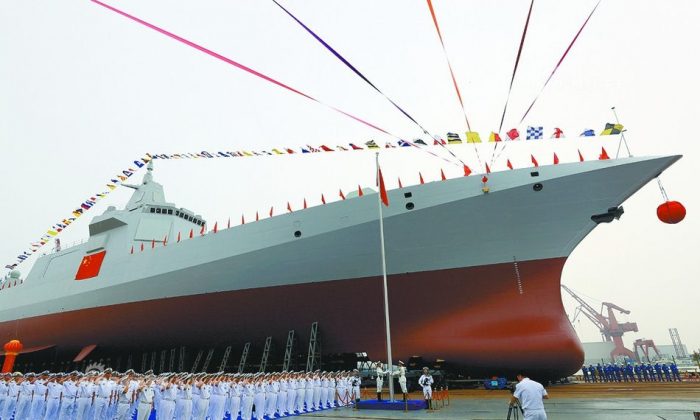
SCREENSHOT VIA WEIBO

This photo uploaded by a Chinese netizen in Wuhan shows that the Chinese navy ship Haiyang-shan (No. 936) is now fitted with what appears to be an electromagnetic railgun.
PAUL HUANG
The Chinese regime’s People’s Liberation Army Navy (PLAN) has fitted a test ship with a prototype electromagnetic railgun, an experimental weapon that could potentially become a name-changer in future naval warfare against United States and its allies. The staterun media report that railgun design, once operational, could be installed on PLAN’s upcoming Type 055 cruisers and make them the “dreadnoughts” of the 21st Century.
On Jan. 31, a Chinese netizen in Wuhan uploaded several photos on Weibo (China’s version of Twitter) showing PLAN’s aging Yuting I-class amphibious ship Haiyangshan (No. 936) has been heavily modified and is now fitted with what appears to be a large turret on the front.
The ship, which was a 390-foot tank-landing ship originally designed to carry tanks and equipment for the PLA ground troops, is now apparently a test ship for the PLAN’s electro-magnetic railgun project. This conclusion is shared by many observers, based on the fact that other available photos of the ship also show various visual features consistent with installations in support of an electromagnetic railgun’s firing.
The railgun is an experimental weapon that uses electromagnetic energy, instead of explosive power, to propel a projectile to inflict damage upon a distant target. In comparison with conventional artillery, the railgun has the potential advantage of firing a much faster projectile at a greater distance—a game-changing weapon, especially in naval warfare. An operational railgun could greatly enhance a warship’s engagement range and lethality against enemy ships, airplanes, missiles, and even ballistic missiles.
For example, a railgun-propelled projectile fired at Mach 7 (seven times the speed of sound) could cover 150 nautical miles (173 miles) in just 2 minutes, which would be 10 times faster than a Harpoon anti-ship missile currently used by the U.S. Navy flying at Mach 0.7 speed (20 minutes), or at least 3 times faster than the conventional naval gun at Mach 2 speed (6 minutes).
Projectiles flying at such high speed would be very difficult to intercept using existing surface-to-air missiles or close-in weapons systems. A railgun firing at such high velocity would also likely have a range in excess of 100 nautical miles, which would be comparable or even superior to the range of conventional anti-ship missiles such as Harpoon. It would also be vastly superior to most conventional naval guns, which typically have ranges of around 10 to 20 miles.
The PLAN railgun looks very similar to the ones the United States is currently experimenting with, according to observers. The U.S. Navy has been working on the development of a railgun weapon for many years, and various videos of their test firings have been released in the past. The U.S. railgun project, however, has not yet reached operational status, and no ship in the U.S. navy has ever been fitted with one.
China could, therefore, be the first-ever country in the world to have fitted an electromagnetic railgun on a ship. Should the gun be test-fired, it would also be the first-ever navy ship to fire an electromagnetic railgun.
The apperrance of a prototype railgun mounted on a ship suggests a breakthrough has been made in PLAN’s development of the weapon, which has been ongoing since at least 1986. This is consistent with an earlier report by The Epoch Times in December 2017 that documented how the Chinese regime made a critical breakthrough in the development of the electromagnetic aircraft launch system used on aircraft carriers.
The railgun is an experimental weapon that uses electromagnetic energy, instead of power from explosives, to propel a projectile to inflict damage upon distant target.
In 2008, a Chinese state-owned company discreetly acquired Dynex Semiconductor, a small British semiconductor company that once held a technical edge in the production of an insulated-gate bipolar transistor (IGBT) chip, which is a critical component in the application of electromagnetic technology.
The acquisition of IGBT from the British company a decade ago led to China’s leapfrogging of electromagnetic aircraft launch technology critical for its aircraft carrier program, and it could also have led to its recent breakthrough with the electromagnetic railgun, since both projects would have benefited from the advance in the IGBT technology.
Rick Fisher, a senior fellow at the International Assessment and Strategy Center had earlier commented on China’s breakthrough in electromagnetic aircraft launch systems as “a tragedy for the United States,” since it would erode U.S. military superiority in ways that could alter the outcome of a conflict with the Chinese regime’s military.
PLAN

In this photo released by China’s People’s Liberation Army Navy (PLAN), the first Type 055 destroyer (classified by Western sources as a cruiser) is being launched in Shangahi’s Jiangnan Shipyard on June 28, 2017.
The railgun could make obsolete the U.S. Navy’s significant investment in advanced conventional naval guns, such as the 155m Advanced Gun System found on Zumwalt-class destroyers. The U.S. Navy reportedly plans to install a railgun on the USS Lyndon B. Johnson, the third and the last Zumwalt destroyer, which is currently under construction. However, there are no plans to fit any other U.S. Navy warship currently in service with a railgun.
Due to the need for a large amount of electrical power (around 25 megawatts) to fire, the railgun is usually thought to be more suitable for larger surface combat warships like cruisers or large destroyers. The most recently launched Zumwalt-class destroyer, for example, can generate 78 megawatts of power thanks to the ship's advanced turbine generators, which makes it the only U.S. Navy surface combat warship that can theoretically operate a railgun.
Soon after the photo of the railgun was widely reported in international media, the Chinese regime mouthpiece the Global Times reported Chinese military experts as saying that PLAN’s state-of-the-art Type 055 cruisers, (classified as destroyers by the Chinese) is the best fit to be equipped with the railgun, as it could meet the weapon’s huge power demand. It is speculated that the four advanced gas turbines on the Type 055 could generate as much as 110 megawatts, even more than those of the U.S. Zumwalt-class.
With the new electromagnetic railguns, the Type 055 will become the “dreadnought” of the 21st Century, said Cheng Shuoren, a Chinese military analyst quoted by the Global Times. The 13,000-ton Type 055 is also equipped with an advanced active phased array radar system and at least 112 tubes of vertical launching system (VLS) cells that contain various missiles.
The Epoch Times reported earlier that the PLAN is building at least five and possibly as many as eight Type 055 cruisers simultaneously, at the same time that the U.S. Navy has no viable plan to replace any of its 22 existing Ticonderoga-class cruisers, which are decades old and unable to mount next-generation weapons such as the railgun.
150
A railgun-propelled projectile fired at Mach 7 (seven times the speed of sound) could cover 150 nautical miles (172 miles) in just 2 minutes.